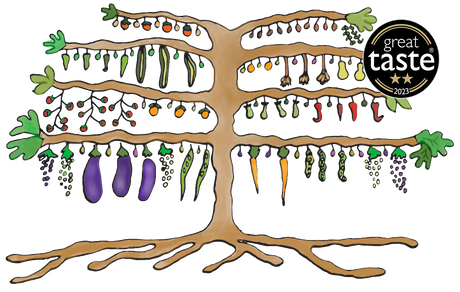Ping. Spring bursts, headlong, certain. Lucid blossom pops on the fringes of the meadow, at the feet of budding vines, on the fingertips of the black-barked almonds. The reaches of the bare walnut canopy chime with chaffinch song.
It is disconcerting, bewilderingly precipitous.
I’m trailing behind the dogs, beyond the olive grove into the spooky shadows of the pine copse on the gentle sloping terrace above the corral. It is a place of whispers, corridors and half light, not so dense, nor too open, the fitting place to bury the sparrowhawk. This is where these birds prey, breathe, strike, belong. On my looping route in and out of the wood I pass two scatterings of feathers, one from a pigeon, the other a blackbird.
The sparrowhawk cupped in my hand - a juvenile, yellow-iris male I think - still had the steel in its half-closed eyebeam; a warrior, as Ted Hughes poem keenly summed, blue shoulder-cloak wrapped about him, weighing just seven ounces. Its Jurassic feet of shocking turmeric yellow, of clinical finesse and power tipped with curling razor black talons, were as perfect as the counter shaded bars on his chest. What a terrible waste.
The last time I had been so close to murderous creation was when its cousin and another farm and valley predator, a goshawk, had broken through the net canopy of our chicken run exactly two years ago. Dim-witted, I had stepped in, over the corpses of two chickens it had dispatched, and tried to usher it out. It looked into my soul. The raptor gaze was as shocking as the bulk. It was a force of nature.
The hawks were dark, untameable, graceless creatures of history, unloved by the falconers with noble peregrines on their gauntlets. Goshawks were deemed vile and fractious, hard to master. For sure their darting, shadowy world is far harder to glimpse, let alone fathom, so different it is from the soaring falcon. But what wonder when you see a hawk, sense the menacing, brutal power from that different world, the one we rarely see and decreasingly sense: the parallel universe inhabited by other Earth creatures who have evolved to perfection, who somehow have the power to shake us humans awake from our ludicrous dream that we know and understand, are wise and supreme.
The sparrowhawk had met his end on the bumpy main road that slices through the rolling vineyards and groves a couple of miles from the farm. In its tunnel-vision, terrain-skimming pursuit of prey it had crossed the path of a truck and lay flinching on the verge the opposite side of the road beyond the crash barrier. There was nowhere for us to pull over and, as ever, crazed Catalan drivers were furiously bunched up behind our bumper like railway carriages. We were heading for the olive mill and decided to check on our return journey to see if the bird was stunned or dead.
It was still there. The life within it had frozen, the beak locked down against the barred softness of its chest. We took it home and then I found a suitable spot to bury it beneath pine needles and two hefty stones, on the lip of the copse with an uplifting open visa of the valley, near the bee orchids.
I drifted deeper into the shadowland. Through the dreamy rhythm of the dark bark I was heading for the bowl of brightness at the far end, the latest crucible of labour where we are trying to make sense of our relationship with this land. On the western fringe of the farm beside a sunken holloway of cane, oak, blackthorn and bramble, we are, as sensitively as possible, steadily freeing a line of old olives from a worryingly combustible tangle. Imagining harvests to come we steadily stack firewood for future winters. We attempt, as we have done all over the place, to thin the dominant forces and to foster diversity, with mixed results. This corner of Mother’s Garden has been abandoned long enough for some of the undergrowth to tower 20 feet above the ancient olives. At intervals the mesh of the hollow has been breached by wild boar whose well-worn paths pattern the valley like the ancient ways of hobbits. And at the deepest point, where in 15 years I have never ventured before (and where we will leave nature alone) I found the half-crater of old badger set beneath a crooked hawthorn.
All this is but 100 metres from our pony’s dusty corral that sits in an elbow of the woodland. What nights frolics the old girl must witness, which explains her propensity to doze in the winter sunshine when out to graze. The creatures – boar, owls, badgers, rabbit, rats and cats that prey on them, weasels, deer – that inhabit that other world we rarely experience, must keep her awake most of the night.
Of all the cats that live off this land, arguably the wildest has wheedled her way into our warm kitchen. Gen Cat is classically feral. Her fat ringtail, her black side stripes on camouflage grey and her fearless countenance suggest her genes are predominantly from the forest. She will take a rodent half her size, refuses to acknowledge the terriers’ hatred, and yet at the same time has the guile to circumnavigate any doubts we might have about letting such a beast on to our laps.
Back in the hollow, as I tickle along with the clearing for an hour a day in the company of all manner of living things, I breathe in the benefit. I can begin to see the progress while weighing lessons learned from living so close to that other world,, fortified by a space I foolishly used to think of as solitude.
Keep well.















0 comments